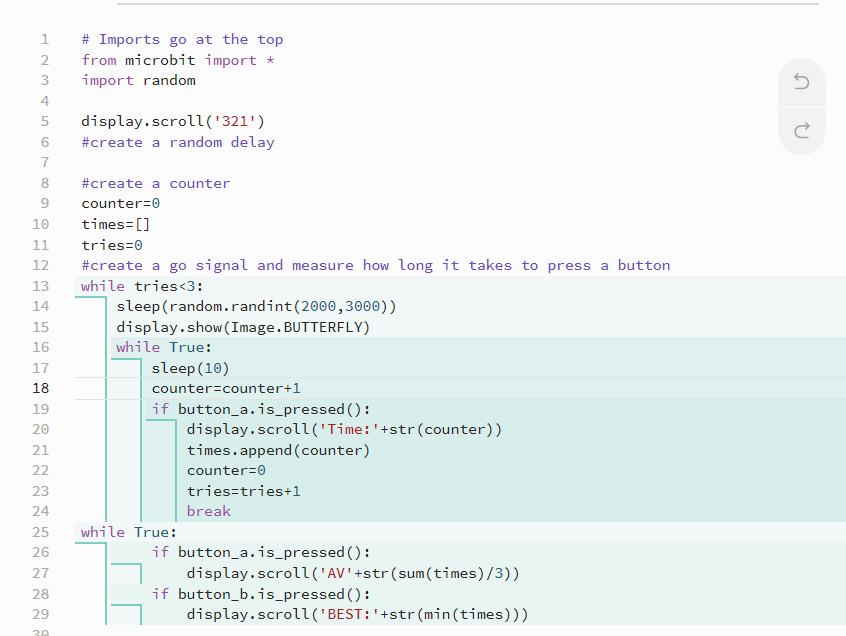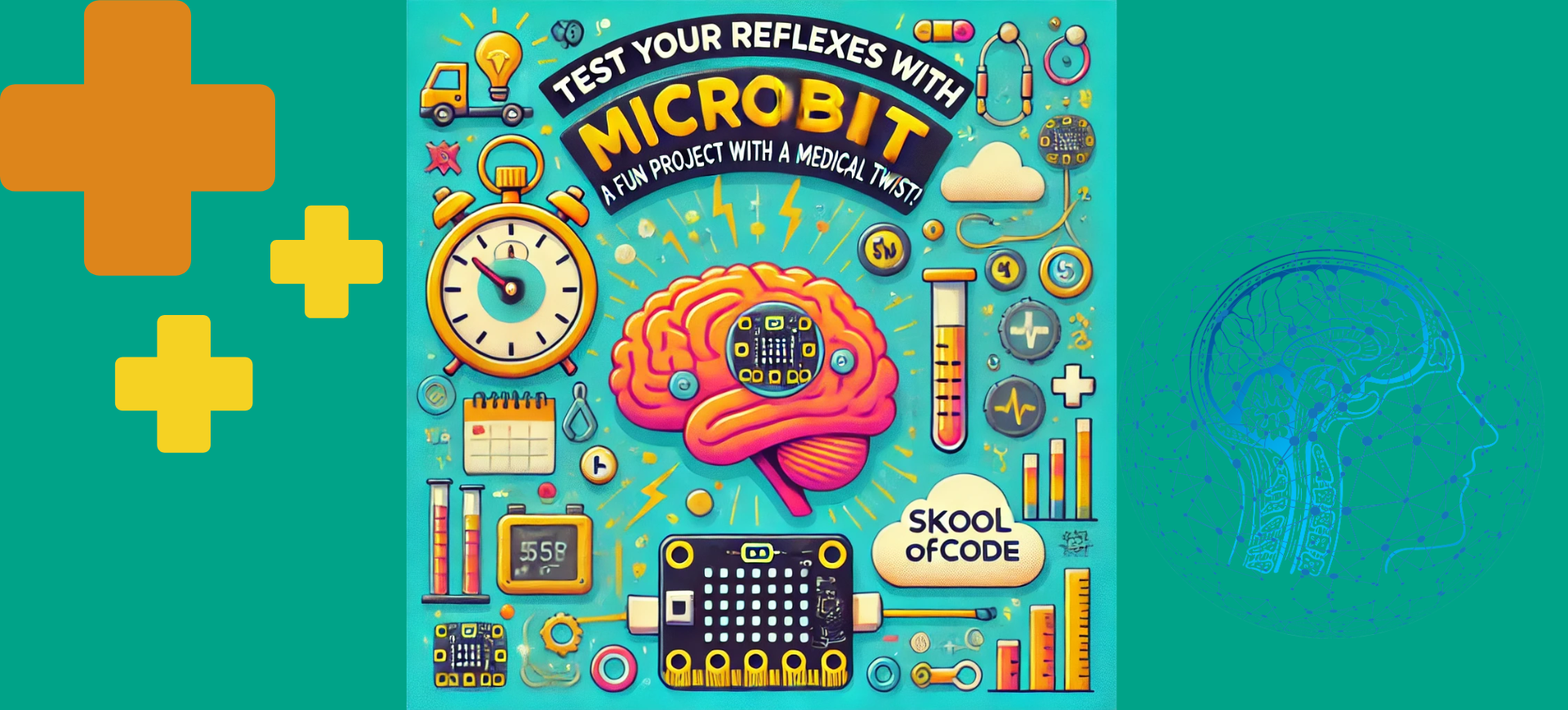Did you know that the average human reaction time is about 250 milliseconds? That’s faster than the blink of an eye! Yet, our reaction times can tell us so much about our overall health and well-being. In this exciting blog post, we’ll explore a fun and educational project using the versatile Microbit to test your reflexes.
The micro:bit, a pocket-sized computer, is packed with features like LED displays, buttons, sensors, and wireless communication capabilities. It’s an excellent tool for young coders to delve into the world of programming and electronics. But this isn’t just any coding project – we’re adding a fascinating medical twist.
Join us as we uncover how this simple yet engaging project can give insights into your health and reaction time, blending fun with science. Let’s dive in and discover the magic of coding with a purpose.
Building the micro:bit Reaction Timer
Materials List
- micro:bit: The brain of our project, a small but powerful microcontroller that will handle all the computations.
- Battery Pack: To power the micro:bit, make your project portable.
Coding the micro:bit
Now, let’s bring your reaction timer to life with some coding! We’ll use Microbit Python editor, a coding platform perfect for introducing Python.
Here’s a sample code snippet to get you started:

Download the Pre-Written Code
To make things easier, we’ve provided the pre-written code to download here. Upload it to your micro:bit, and you’re ready to go.
Building a micro:bit reaction timer is not just a fun project; it’s a hands-on way to learn about electronics and programming. Plus, it gives you a unique insight into your reaction times, blending technology with personal health. Happy building.
Test Your Reflexes: Unleash Your Inner Superhero with micro:bit
Ever wonder if you have the reflexes of a lightning bolt? Now you can put your skills to the test with a super fun and easy-to-build micro:bit reaction timer!
This isn’t just about bragging rights (although those are definitely on the table). Here’s the cool part: by playing this game, you’re also exploring a concept used in the medical field to measure alertness!
Get Ready, Get Set, micro:bit
Playing is a breeze. Just hold the micro:bit in your hand, and get ready for the challenge. Suddenly, an image will flash on the screen – that’s your clue! The faster you press the button, the quicker your reaction time. Each successful reaction will add your score to the list, so you can see your progress in real time. You will get three chances and by pressing button A you can check the average of Reaction times and by shaking you can get the best of Reaction times.
Challenge Accepted: Friends and Family Face-Off
This isn’t a solitary pursuit! Gather your friends and family, and transform your living room into a reflex battleground! Take turns testing your lightning-fast reactions and see who emerges victorious. Keep track of your scores and crown the ultimate micro:bit Reflex Champion.
How to Play
Get ready to test your reflexes with this exciting micro:bit reaction timer game! Here’s how to play:
- Set Up the Game: Make sure your micro:bit is connected and powered up.
- Starting the Game: Press Button A to start the game.
- Reading Your Score: The micro:bit will display your reaction time in milliseconds on its LED display. The faster you press Button B, the lower your reaction time will be.
Fun with Friends
Why play alone when you can challenge your friends and family? This reaction timer game is perfect for a friendly competition. Here’s how you can make it more exciting:
Keep Track of Scores:
- Create a scoreboard to track each player’s reaction times. The player with the fastest reaction time wins!
- You can use a simple notepad or even an Excel sheet to log the times and determine the overall champion.
Coding for Kids:
- Encourage children to dive into coding by exploring how the micro:bit reaction timer works. Our online coding classes for kids offer the perfect platform to learn the basics of coding with micro:bit for beginners.
- By modifying the code, kids can add new features like sound effects, different levels of difficulty, and more, enhancing their understanding of coding with micro:bit and Python.
Educational and Fun:
- While having fun, kids are also learning important STEM concepts. This project combines electronics, programming, and cognitive science, making it a comprehensive educational tool.
- Our online coding classes for kids make it easy to get started with projects like this, ensuring that learning is both engaging and effective.
So, gather your friends and family, set up your micro:bit reaction timer, and see who has the quickest reflexes. Not only will you have a blast, but you’ll also be honing your coding skills and learning new concepts along the way. At SkoolOfCode, we’re all about making learning fun and interactive. Get started today and discover the thrill of coding for kids.
The Science Behind the Fun
What is Reaction Time?
Reaction time is the interval between a stimulus’s presentation and your response’s initiation. It measures how quickly you can respond to a visual or auditory signal. In our micro:bit project, reaction time is measured by the time it takes for you to press button A after an image (stimulus) appears on the micro:bit screen. Also, you can check the average Reaction time ( 3 chances) and by shaking the micro:bit you can check the best of Reaction times.
Measure Your “Dumbness” with a Ruler
Here’s a fun, classic technique to measure reaction time with just a ruler. This simple method, often referred to as the “ruler drop test,” provides a rough estimate of how quick your reflexes are.
Materials: All you need is a standard ruler.
Procedure:
- Have a friend hold the ruler vertically, with the zero mark at the bottom.
- Position your hand so that your thumb and forefinger are ready to catch the ruler at the zero mark.
- Your friend should release the ruler without warning, and you should catch it as quickly as possible.
- Note the point where you caught the ruler. The number indicates the distance it fell before you caught it.
Calculation:
- Use the formula Reaction Time=2×Distanceg\text{Reaction Time} = \sqrt{\frac{2 \times \text{Distance}}{g}}Reaction Time=g2×Distance where g is the acceleration due to gravity (approximately 9.8 m/s²).
- For example, if you caught the ruler at the 20 cm mark, your reaction time would be approximately 0.2 seconds.
This fun test is a great way to get a hands-on understanding of reaction time and can be a perfect complement to the more precise measurements made by the Microbit.
Alertness and Reaction Time
Your reaction time is a direct reflection of your alertness and cognitive function. When you are well-rested and focused, your brain processes signals more quickly, leading to faster reaction times. Conversely, factors like fatigue, stress, and distractions can slow down your response. Monitoring your reaction time can provide insights into your overall mental sharpness and how well your brain is functioning at any given moment.
Medical Applications
Reaction time tests are more than just a fun way to challenge your reflexes; they have significant applications in the medical field. Healthcare professionals use reaction time measurements to assess a patient’s alertness and cognitive function. Here are a few examples:
- Neurological Assessments: Reaction time tests help diagnose conditions like multiple sclerosis, Parkinson’s disease, and traumatic brain injuries by revealing delays in cognitive processing.
- Sleep Studies: Researchers use reaction time tests to evaluate the impact of sleep deprivation on cognitive performance, aiding in the diagnosis of sleep disorders.
- Medication Effects: Doctors monitor reaction times to understand how certain medications impact brain function, ensuring they are safe and effective for patients.
SkoolOfCode: Integrating STEM Learning
At SkoolOfCode, we believe in providing integrated learning experiences that go beyond traditional coding for kids. Through projects like the micro:bit reaction timer, our students gain knowledge across various STEM fields. This approach not only enhances their coding skills but also deepens their understanding of electronics, physics, and even medical science.
Our online coding classes for kids are designed to make learning interactive and fun. For instance, when students work on projects with Microbit using Python, they learn to code while also exploring the principles of time measurement and human physiology. This holistic method ensures that our students are not just learning to code but are becoming well-rounded problem solvers and critical thinkers.
By introducing micro:bit for beginners, we provide a hands-on approach that encourages young learners to experiment and innovate. Whether it’s creating a reaction timer or another exciting project, SkoolOfCode’s integrated learning model ensures that children develop a robust foundation in STEM subjects, all while having fun with coding.
Understanding the science behind reaction time not only enhances your appreciation of this fun project but also highlights its relevance in real-world health assessments. By blending technology with medical science, we can gain valuable insights into our brain’s performance and overall well-being. At SkoolOfCode, we are committed to nurturing the next generation of tech-savvy, scientifically literate innovators.
By –Dr. Kadam Bhambari, an Educator at SkoolofCode with Ph.D. and MTech in Electronics. She is an expert in micro:bit, Arduino, and Artificial intelligence.

